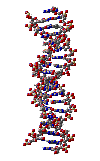|
Helicobacter pylori – the key behind its recognition is somewhere else (10/2004)
The first step against infection is the detection of microorganisms capable of causing disease. This is done through the recognition of molecular structures not shared by the host, but also present in other harmless or even useful microbes. A question that has puzzled scientists for many years is how the host knows exactly against which microbes to mount an immune response. But now, in the November issue of Nature Immunology1, scientists describe for the first time an ingenious bacteria-recognition mechanism by epithelial cells, which allows the distinction to be made between dangerous and innocuous bacteria.
The innate immune system is the mammals’ first line of defence as it can be mobilised almost immediately, and so has a crucial role in the prevention and/or fight of infection. Key players in the recognition of bacteria are two families of receptors: Toll-like receptors (TLR), which are normally expressed in cell membranes, and the nucleotide-binding oligomerization domain (Nod) family, found in the cytoplasm.
A simple system by which the innate immune system can differentiate between pathogenic (disease-inducing) and non-pathogenic bacteria is by selective expression of these receptors. For example, TLR and Nod receptors, specific for bacterial molecular components, are expressed in sterile areas of the body like the internal organs, the bloodstream or the cytoplasm. The logic behind this is that if bacteria are found at those locations it would be as result of an infection and consequently an immune response should be mounted. This differential receptor expression however, can not explain how in places like the digestive system, where a varied population of both pathogenic and non-pathogenic extracellular bacteria exist, we are still able to discriminate and attack only the those which can induce disease.
But now Jérôme Viala , Catherine Chaput, Ivo G. Boneca, Richard L. Ferrero and colleagues at the Institute Pasteur in Paris, the National University of Ireland and the Millenium Pharmaceuticals in Cambridge, Massachusetts, USA while working on the mechanism of recognition by epithelial cells of a pathogenic variant of Helicobacter pylori (H. pylori) which is associated with ulcers and stomach cancer, found one such mechanism of discrimination between “good” and “bad” bacteria.
The team of scientist discovered that the inflammatory reaction of epithelial cells in response to H. pylori was triggered through Nod1, a member of the Nod receptor family, localised in the cytoplasm of the epithelial cells. This was very interesting, as H. pylori does not enter the cells during infection and until now was thought to be recognised through a member of the TLR family, which are normally localised on the cell surface.
In addition, Viala , Ferrero and colleagues also show that the activation of Nod1 and subsequent inflammatory response against infection, was dependent of a bacterial syringe-like structure called type IV secretion system.
Further experiments led to the discovery that H. pylori induces an inflammatory response in gastric epithelial cells by injecting peptidoglycan, a component of the bacterial cell wall, into these cells through a type IV secretion system. The peptidoglycan is then recognised in the cytoplasm by Nod1 leading to the production of pro-inflammatory molecules, which will start an immune response against the pathogenic bacteria. It is not clear why bacteria have conserved such a mechanism if, as it seems, it can be harmful for their survival but one hypothesis is that it might have advantages not yet discovered.
These results are extremely interesting when considering the fact that while most pathogenic bacteria present this type of syringe-like secretion systems, non-pathogenic bacteria, on the other hand, generally do not have such systems of interaction. A good example is non-pathogenic variants of H. pylori which have no secretion system.
Viala , Ferrero and colleagues’s work is very important for the understanding of how the body deals with infection not only because it shows that an intracellular receptor (Nod1) can recognise an extracellular bacterium without this entering the cytoplasm, but also because it describes for the first time a bacterial recognition system that is able to discriminate between dangerous and innocuous microorganisms and mount a response only when necessary.

1 Nature Immunology (2004); Vol. 5 (11), pp. 1166-1174
" Nod1 responds to peptidoglycan delivered by the Helicobacter pylori cag pathogenicity island”
Original paper’s authors
Link to the original paper
|
In collaboration with the Observatório da Ciência e do Ensino Superior (OCES)
Financed by the Fundação para a Ciência e Tecnologia (FCT) |





